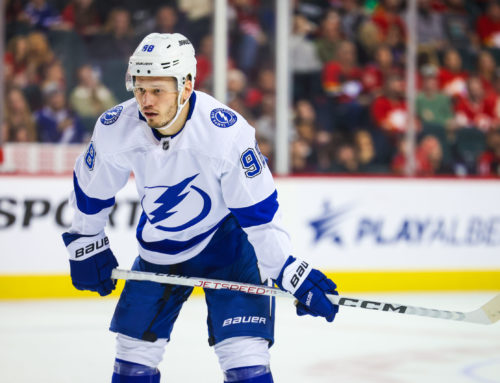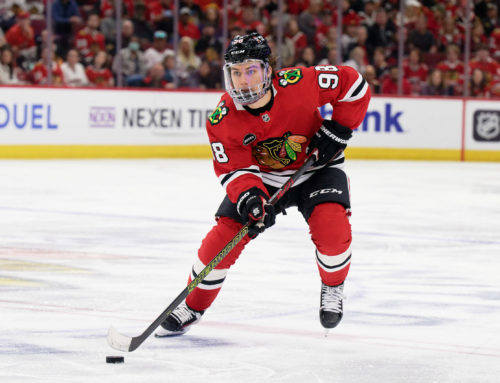Projections at the Halfway Mark
Ryan Ma
2010-01-12

Littered throughout the forum are plenty of questions regarding what's so-and-so's upside for the rest of the season. Or he's on a … point-per-game pace can he keep it up? This injured player is coming back what's going to happen to player x? Do you like player x or player y? There's a very simple solution to finding the answer to each of those questions, and it lies within the numbers. For those of you who have been avidly following my columns, you would realized that I'm a heavy stats-oriented guy, so this week I'm going to try to rationalize some projections by attaching some numerical values along with them.
As always, before the good stuff, let's take a look at a few:
Maaasquito Buzzings…
Players in the last seven days with the highest production in each category who are less than 50% owned in Yahoo leagues.
|
Goals |
Assists |
+/- |
PPP |
SOG |
|
Latendresse (4) |
Sullivan (4) |
Koivu (7) |
Sullivan (4) |
Hornqvist (22) |
|
Hornqvist (4) |
Brodziak (4) |
Salo (7) |
Hornqvist (4) |
Moss (18) |
|
Vermette (3) |
Latendresse (4) |
Mitchell (6) |
Lombardi (3) |
Latendresse (18) |
|
Belanger (3) |
Vermette (3) |
Brookbank (5) |
Brouwer (2) |
Vermette (14) |
|
Beleskey (3) |
Koivu (3) |
Festerling (5) |
Liles (2) |
Langkow (13) |
Maaaasquito Bite of the week: Guillaume Latendresse
In mid-November, the Wild and Canadiens made a very intriguing deal that gave new addresses to two fairly high profile prospects. The Habs picked up Benoit Pouliot while Minny acquired Latendresse. So far it's turned out to be a win-win situation for both parties as Pouliot has four points in nine contests with Montreal, while Latendresse has been blazing hot while picking up 15 in 21 for the Wild. Latendresse does have a very interesting history, as he was chosen right after Sidney Crosby in the2003 QMJHL entry draft and posted 210 points and 247 PIMs in 169 career contests with the Drummondville Voltigeurs. With the Wild, he's essentially replacing the spot that P.M. Bouchard should have been occupying as he's spending 57.1 percent of his overall ice-time alongside Martin Havlat. Latendresse is also averaging 1:58 on the PP and 16:19 in each contest, which aren't exciting overall numbers, but given the way how the Wild manage their ice-time, it's probably more than enough for him to make a mark fantasy-wise for the remainder of this season. An added bonus is the fact that he also has dual winger-eligibility, which should give fantasy rosters a bit more flexibility when it comes to scheduling. Definitely hit the add button for the six percent owned winger if you are in need of some help on either wing.
Now onto the good stuff.
First, let’s clear up some general misconceptions about projections:
- First of all we need to place a realistic value on overall point production.
- Last season, only 17 players operated at above the point-per-game mark and 23 players the year before that, so if you are looking at the grand scheme of things there are two maybe three players on a typical 12-team fantasy squad that are really capable of tallying above the point-per-game and not five or six as many of you are probably expecting.
- Of those players 17 players all of them were essentially on their team's number one top-line, so if you own someone that interchanges between second line/top line duties, there is a high chance that they won't hit the point-per-game mark.
- So what can you draw from this? There are 19 players who are currently operating at above the point-per-game pace including Andrei Markov. Essentially all of those players are top-line players or play fairly important roles on their respective squads and I don't really see any of them slipping out.
- What you do need to pay attention to is the group that is a smidge below the mark: Corey Perry, Jarome Iginla, Anze Kopitar, Jonathan Toews and Mikko Koivu could also enter the above group, but players with non-top-line roles like Loui Eriksson and Rene Bourque may not.
2) Team depth is vitally important; a player playing on the third line isn't going to be a candidate for 80 points, or even 60 according to the numbers below.
3) Salary plays a large role in ice-time distribution, and generally speaking if a team is forking out six million or higher in salary for a player, they are going to receive optimal ice-time. In the salary cap era of the NHL, teams will be very hard-pressed to stick a player making bucket-loads of cash on a checking line.
o A perfect example is what the Oilers are doing with Shawn Horcoff. They won't green light Sam Gagner or Gilbert Brule, but continue to give Horcoff 19:52 a contest despite his minus 20 rating.
4) Ice-time plays a huge factor in point production.
o Every forward in the top 50 in scoring garners over 17 minutes of ice-time.
o In the top 100, essentially every player was garnering above the 16:30 mark with the exception of Steven Reinprecht(16:13), J.P. Dumont(16:14), Tomas Fleischmann(16:23) and Chris Stewart(15:25). I wouldn't count players like Dustin Byfuglien, David Perron and even Scott Hartnell to increase their point production, unless things change, for the second-half of this season.
5) The Western Conference teams are a slightly more offensive of the two conferences.
o The Western Conference teams average 2.79 goals, while the Eastern Conference teams average 2.75.
o If you have a comparison between two players in a similar point range, choosing the player in the Western Conference might give you a slight point advantage over the Eastern Conference player.
6) Beware of expecting breakout rookie seasons.
o Last season only seven rookies surpassed the 45 point mark. Bobby Ryan and Kris Versteeg topped the list with 57 and 53 points respectively, so keep John Tavares, Matt Duchene and Niclas Bergfors and even James Van Riemsdyk's projections in check in the second stanza.
7) Be wary of the second-half of the "magical fourth year"
() current point pace.
o Anze Kopitar 61, 77, 66, (78)
o Paul Stastny 78, 71, 36, (73)
o Joe Pavelski 28, 40, 59, (57*)
o Loui Eriksson 19, 31, 63, (78)
o David Moss 18, 11, 39, (26*)
o Patrick O'Sullivan 19, 53, 43, (42*)
o Second half numbers during the "magical fourth year" of recent fourth year breakouts: Mike Richards 1.03, Ryan Getzlaf 1.06, Pavel Datsyuk 1.17, Zach Parise 1.11, Ilya Kovalchuk 1.08, Jeff Carter 0.92, Mike Cammalleri 1.19.
o I can see Kopitar and Stastny joining the above list, but probably not Pavelski, Eriksson, Moss or O'Sullivan.
Now onto the real mathematical stuff. Keep in mind these are general average numbers, there may be certain exceptions to each scenario.
Centers
– A top 10 point-producing center is averaging 44.4 games played, along with 17.2 goals, 32.5 assists, 123.3 SOG and 20:48 in ice-time during the season.
– A 60 point-producing center averages 42.1 games played, along with 11.1 goals, 21.9 assists, 106.6 SOG and 19:51 in ice-time during the season.
– A 50 point-producing center averages 40.2 games played, along with 10.5 goals, 16.1 assists, 95.4 SOG and 18:26 in ice-time during the season.
– A 35 point producing center averages 40.0 games played, along 7.7 goals, 12.6 assists, 81.5 SOG and 17:10 in ice-time during the season.
Left Wings
– A top 10 point producing left wing averages 41.5 games played, along with 20.2 goals, 21.9 assists, 141.9 SOG and 19:54 in ice-time during the season.
– A 60 point producing left wing averages 42.2 games played, along with 15.2 goals, 17.8 assists, 120.8 SOG and 18:11 in ice-time during the season.
– A 50 point producing left wing averages 39.6 games played, along with 12.1 goals, 14.6 assists, 96.3 SOG and 17:15 in ice-time during the season.
– A 35 point producing left wing averages 40.5 games played, along with 16.1 goals, 9.5 assists, 70 SOG and 14:23 in ice-time during the season.
Right Wings
– A top 10 point producing right wing averages 44.2 games played, along with 18.4 goals, 24.9 assists, 138.6 SOG and 20:17 in ice-time during the season.
– A 60 point producing right wing averages 41.7 games played, along with 11.7 goals, 18.1 assists, 108.3 SOG and 18:14 in ice-time during the season.
– A 50 point producing right wing averages 43.7 games played, along with 11.4 goals, 14.7 assists, 105.1 SOG and 16:00 in ice-time during the season.
– A 35 point producing right wing averages 36.8 games played, along with 9.1 goals, 9.6 assists, 78.6 SOG and 16:43 in ice-time during the season.
Defenseman
– A top 10 point producing defenseman averages 44.5 games played, along with 6.7 goals, 25.4 assists, 91.5 SOG and 24:36 in ice-time during the season.
– A 40 point producing defenseman averages 43.5 games played, along with 5.9 goals, 16.1 assists, 75.8 SOG and 22:05 in ice-time during the season.
– A 30 point producing defenseman averages 40.1 games played, along with 3.3 goals, 12.7 assists, 62.8 SOG and 21:18 in ice-time during the season.
– A 25 point producing defenseman averages 39.2 games played, along with 3.2 goals, 10.8 assists, 50 SOG and 20:45 in ice-time during the season.
Goalies
I didn't know how to tier the goalies without getting 50 billion complaints about how I did it, so I guess I'll just state some quick points.
o Eight goalies are on pace to finish with 40 or more wins, compared to just two last season.
o Four more are on pace for 35 wins or more.
- Which tells me that more teams are using the number one/number two option than a 50/50, 60/40 type tandem from last season.
– Six goalies are on pace to play 70 games or more. (Jon Quick, Martin Brodeur, Ilya Bryzgalov, Henrik Lundqvist, Evgeni Nabokov and Miikka Kiprusoff)
– The average top-40 goalie picked up 14.1 wins while starting 28.6 games so far this season.
– Of those 40, only five goalies had a win percentage of 60% or higher along with a minimum of 30 games played. They are Brodeur, Nabokov, Cristobal Huet, Ryan Miller and Roberto Luongo)
– When averaging the top five goalies in wins, you get stats of roughly, 24.6 wins, 64 percent win percentage, 2.18 GAA, and a .926 save percentage.
– A goalie that currently has 20 wins have stats of roughly, 36.8 starts, 54 percent win percentage, 2.46 GAA, and a .912 save percentage.
– A goalie that currently has 15 wins* have stats of roughly, 29.3 starts, 52.3 percent win percentage, 2.51 GAA, .919 save percentage.
– A goalie that currently has 10 wins have stats of roughly, 21.8 starts, 45.8 percent win percentage, 2.36 GAA, .910 save percentage.
*only a sample of three players.
So you're probably sitting there wondering, there's a whole bunch of numbers, what does it all mean? Here's three examples of how I would use the numbers to determine the second-half.
Let's take a look at Maxim Afinogenov's stats, he played in 44 games, while averaging 17:57 in ice-time and has 97 SOG. He's spending a bit of time on a line with Nik Antropov and Kovalchuk, while seeing a bit of time on the PP (2:51) and he's a right wing. He has 40 points in 44 contests, which means that he's on pace to finish the season with 75 points, which would place him in the top-10 bracket. Compared to his counterparts, he's off in his SOG by about 40 SOG, and off in ice-time by about two and a half minutes. So it's safe to say that those numbers will return back to earth and finish around the 55-60 point mark.
Let's try a second example to make sure that we're all on the same page. Andrew Brunette has played 45 games this campaign. He's averaging 17:05 in ice-time while firing 81 SOG, and is on a 65-point pace, but his ice-time and SOG average is equivalent to that of a 50-point left winger. Looking deeper into the numbers the 17:05 still ranks fourth amongst the forwards in Minnesota, so that's not so bad, but the SOG is still a bit low. I'd probably say that he finishes the season with around 55-57 points, which would give him around 20 points in the next 37 contests, and very much droppable if you are a Brunette-owner.
For a third example we can take a backwards approach. Shane Doan has 28 points in 46 contests while compiling 140 SOG and averaging 19:51 per game. According to the right wing projections, those numbers should sit Doan at the near top-10 pace not a 50-point pace. I would certainly expect an increase in point production for the second-half of this campaign, and would target him as a buy candidate moving forward.
So hopefully you can use the guidelines above, along with the numbers to help you gain a better grasp of what to expect for player X moving forward. Of course if you are desperately seeking different opinions, hop onto the DobberHockey Forum and there will be plenty of fantasy fanatics who are ready and willing to give you're their opinions. Questions or comments? Like always I'll be ready and willing to discuss them with you in the comments section below. I hope to see you guys back here again next week to discuss more from the Western Conference.





 BUF
BUF N.J
N.J PHI
PHI MIN
MIN FLA
FLA WPG
WPG VAN
VAN TOR
TOR CGY
CGY COL
COL